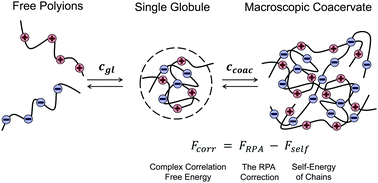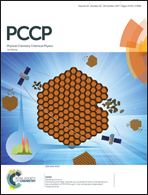Explicit description of complexation between oppositely charged polyelectrolytes as an advantage of the random phase approximation over the scaling approach
Abstract
A polyelectrolyte complex (PEC) of oppositely charged linear chains is considered within the Random Phase Approximation (RPA). We study the salt-free case and use the continuous model assuming a homogeneous distribution of the charges throughout the polyions. The RPA correction to the PEC free energy is renormalized via subtraction of polyion self-energy in order to find the correlation free energy of the complex. An analogous procedure is usually carried out in the case of the Debye–Hückel (DH) plasma (a gas of point-like ions), where the infinite self-energy of point-like charges is subtracted from the diverging RPA correction. The only distinction is that in the PEC both the RPA correction and chain self-energy of connected like charges are convergent. This renormalization allows us to demonstrate that the correlation free energy of the PEC is negative, as could be expected, while the scaling approach postulates rather than proving the negative sign of the energy of interactions between the blobs. We also demonstrate that the increasing concentration of oppositely charged polyions in the solution first results in the formation of neutral globules of the PEC consisting of two polyions as soon as the concentration reaches a certain threshold value, cgl, whereas solution macroscopic phase separation (precipitation of globules) occurs at a much higher concentration, ccoac, ccoac ≫ cgl. Partitioning of polyions between different states is calculated and analytical dependencies of cgl and ccoac on the polyion length, degree of ionization and solvent polarity are found.



 Please wait while we load your content...
Please wait while we load your content...